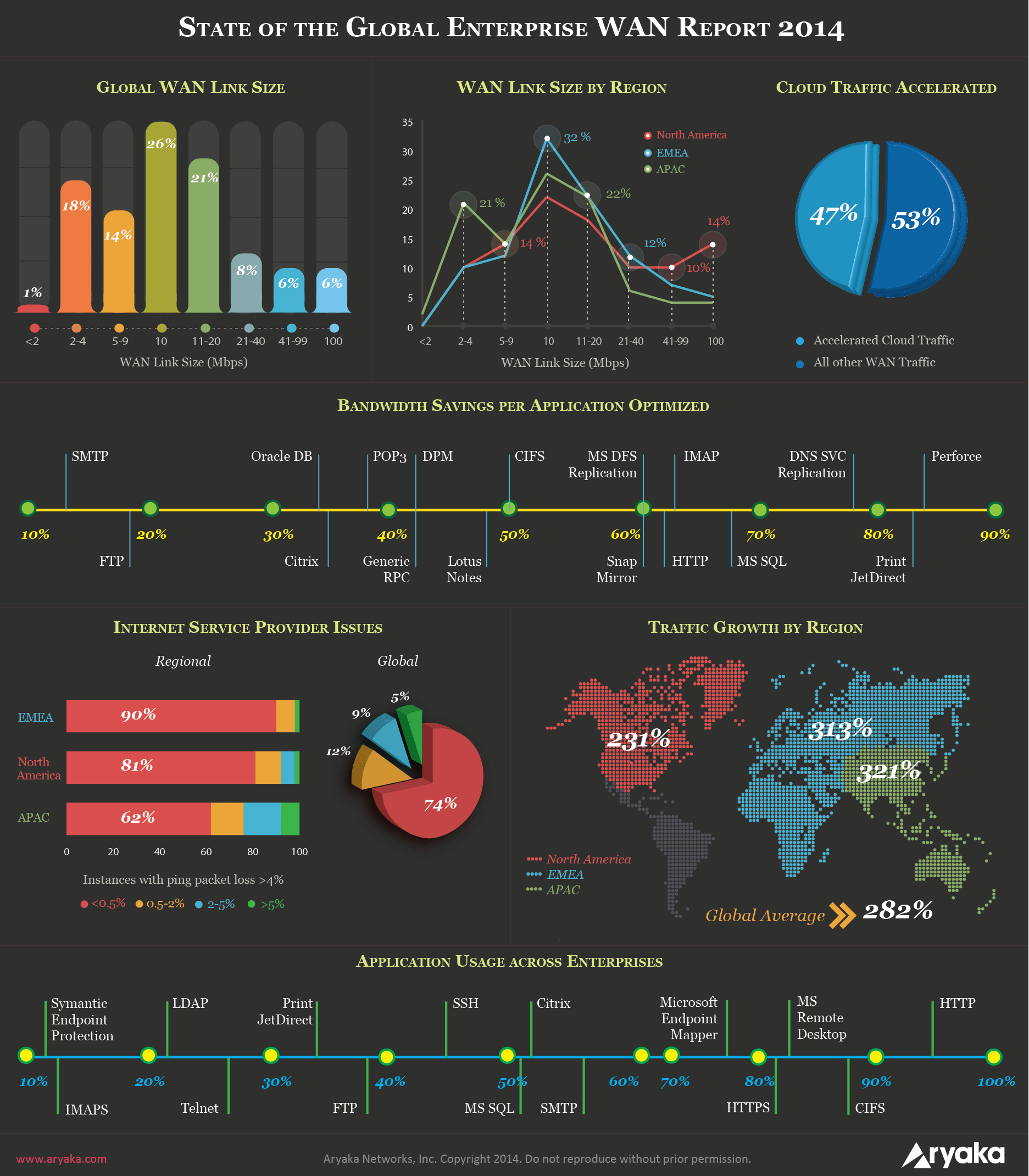Aryaka’s 2014 State of the Enterprise WAN Report: 5 Key Findings [Infographic]
Worldwide, the demand for business-class Internet connectivity is sky high. In 2013, traffic growth rose by 282% worldwide, with Asia leading the surge, with a 321% growth rate. Asia, however, was also the region with the least reliable last-mile connections (more on that in a minute).
The 2014 State of the WAN report is based on aggregate data collected from Aryaka’s globally distributed points of presence (POPs), a worldwide private network, and centralized Wide Area Network (WAN) and application-layer visibility. Anonymous data in aggregate was collected from hundreds of customer sites worldwide, with the focus being on “enterprise access sites,” such as branch offices, overseas supplier sites, manufacturing centers, and product development and testing sites.
1. Cloud and Web traffic are driving Internet traffic growth
When we looked at enterprise WAN traffic traveling over the Aryaka network in 2013, one type of traffic clearly dominated: HTTP and HTTPS. What this indicates is that applications are continuing to transition away from monolithic, on-premises applications to web-based consumption and delivery models.
- 96 percent of our enterprise customers send HTTP traffic over the WAN.
- For those 96 percent of companies sending HTTP traffic, an average of 24 percent of all traffic that each company individually sends over the Aryaka WAN is HTTP traffic.
- Adding HTTPS to this metric, many companies are seeing 40 percent or more of their WAN traffic is HTTP-related.
If you would like to re-publish this infographic on your own website or blog, please use the embed code below!
BR© 2014 Aryaka
2. Accelerated Cloud access is the new cloud trend to watch
- Cloud computing is actually beyond mainstream. A critical tipping point has been reached. More than 11 percent of our customers are now accelerating access to cloud services via Aryaka. (It’s important to note that this 11 percent metric is specifically for accelerated access, which almost certainly under-represents the importance of cloud computing to today’s global enterprise.)
- More importantly, of those companies accelerating cloud traffic, nearly 47 percent of all traffic from these companies ends up being accelerated cloud-related traffic, implying that their investment in cloud services is serious and permanent.
- Traditional approaches (MPLS, VPN) to overcoming bandwidth constraints aren’t suitable to the cloud age. These approaches are too expensive, don’t scale, and can’t guarantee performance to an increasingly distributed user base.
- Interestingly, the cloud’s problems (bandwidth issues, latency and packet loss problems) are actually best addressed by cloud-based optimization services.
3. Last-mile bandwidth improving worldwide
Aryaka’s data show that worldwide last-mile Internet access isn’t as bad as many believe, with last-mile bandwidth rates for most access sites actually better than the typical 1.5-6 Mbps MPLS connection sizes everyone has come to expect.
- Worldwide 61 percent of sites have last-mile WAN links in the 5-20 Mbps range
- North American and EMEA sites have the highest percentage of high-speed links (>20 Mbps) at 34 percent and 24 percent, respectively
- India and China have the highest percentage of sites with links <5 Mbps at 25 percent and 19 percent
4. Worldwide unaided Internet traffic isn’t bad, but it isn’t business-class
As the enterprise becomes more globally distributed, however, improving last-mile bandwidth will likely not keep up with end-user demand. Moreover, enough packet-loss issues plague enough regions that unaided business-class Internet will not be suitable for many mission-critical applications, especially those accessed from a distance. (We include the qualifier “unaided,” since this is not what our end users actually experience, due to Aryaka’s multi-segment architecture, which bakes in a number of optimization and compression mechanisms. Our testing was conducted in a way that measured the effect of unaided last-mile links for comparison purposes).
- North American access sites are lagging behind EMEA
- EMEA has the highest percentage of sites with high-speed connections or last-mile WAN links > 10 Mbps
- Enterprises in all regions show a strong demand for flexible network services
5. Global businesses need new ways to ensure application performance in the cloud age
As ISPs continue to improve their networks and as technology costs continue to drop, unaided enterprise Internet access link quality is becoming fairly acceptable worldwide. However, packet loss and various congestion issues continue to show up disproportionately in APAC. Even North America and EMEA aren’t immune to some packet-loss and congestion issues.
Even if unaided last-mile bandwidth is improving, the Internet experience of many locations worldwide is far from enterprise-class. To keep up with demand, global businesses will need to start investigating solutions that ensure reliable performance for cloud applications and for those applications accessed from a great distance.







